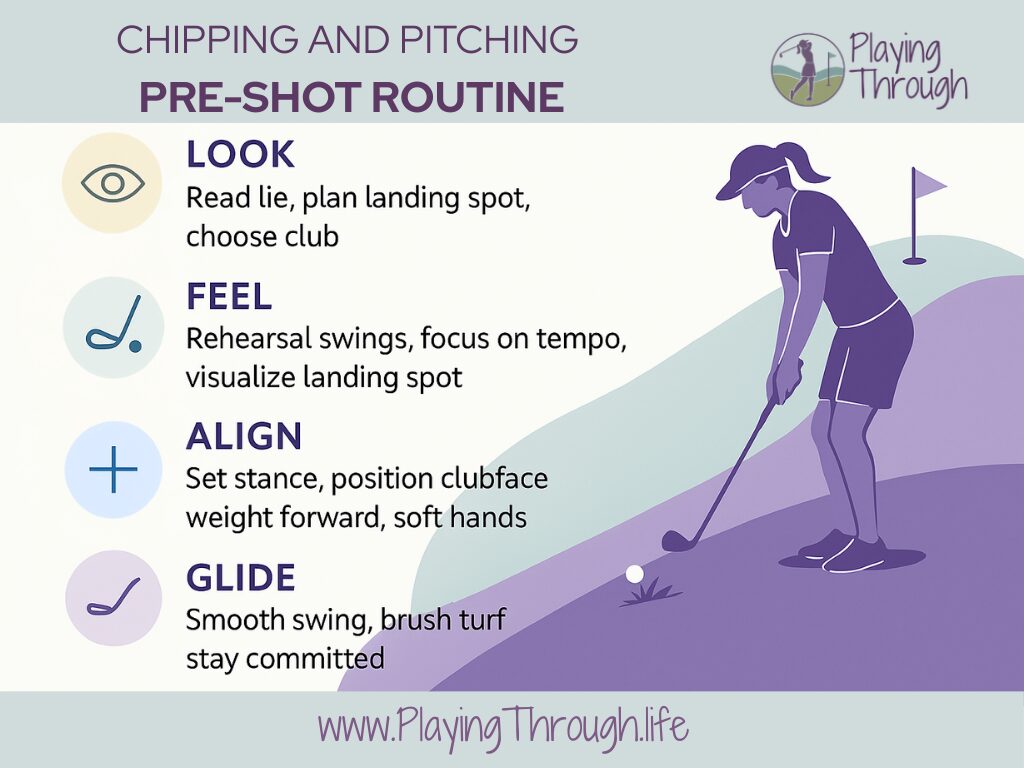
A chipping routine built for tempo, trust, and a little less chunk.
I used to step up to a chip shot and hope for a miracle—or at least a clean hit. Sometimes I got one. Most of the time, I got ball-first bounce rockets or ground-before-club dig fests. And that’s when I realized: I had no chipping routine. No process. Just vibes. Unreliable, panicky vibes.
So I built one.
This is my go-to pre-shot routine for chipping and pitching. It helps me simplify, commit, and stop trying to fix my technique mid-swing. It’s structured, repeatable, and tempo-driven—exactly what I need around the green when the “fix it” voice starts to whisper.
🔁 The Chipping Routine I Rely On:
1. Look
Scan the lie. Pick a landing spot. Visualize the rollout. I remind myself what the club is supposed to do—and what the ground is going to give me. No guessing. Just reading.
2. Feel
Take a few practice swings with purpose. Not just warm-up swipes—actual rehearsal motions that match the tempo and loft I’m aiming for. I don’t need perfect contact; I need confidence in the motion.
3. Align
Set my feet. Check my clubface. Get my shoulders parallel. I breathe here, once, and remind myself to stay soft. This is the last checkpoint before I commit.
4. Glide
This is the swing. I don’t jab. I don’t steer. I let the club do its job. Low tension. Smooth tempo. And yes—sometimes I say “glide” in my head as I do it.
🎓 Coach’s Corner: The BLT Setup
One of the most helpful tips I’ve gotten came from a coach who broke it down like this:
BLT = Ball Back, Lean, Tilt.
Ball back in stance
Keeps the contact crisp and forward.Lean on lead foot
Encourages downward strike and clean turf interaction.Tilt the shaft forward
Promotes solid compression and prevents flipping.
Then comes the swing—not a wristy flick, not a decel panic move. Think putting stroke: shoulders rocking the club back and through. Distance isn’t about speed; it’s about swing length. Short chip? Short stroke. Longer carry? Bigger arc.
It’s simple, repeatable, and when paired with my routine, it feels automatic.
🧠 Why It Works
This routine gives me structure when my brain wants to scramble. It lets me stay athletic instead of mechanical, and it replaces overthinking with deliberate preparation. I’m not trying to fix my technique mid-swing anymore. I’m just executing a plan.
📌 Practice Note
I rehearse this routine during backyard sessions and range work—because it won’t show up on the course unless it shows up in practice first. “Look. Feel. Align. Glide.” It’s not magic. It’s just finally giving my short game the attention it deserves.
🟢 In Play at Fellows Creek
I brought the “Look. Feel. Align. Glide.” routine into my most recent league round at Fellows Creek — and let’s just say, it earned its keep. The course gave me plenty of chances to test it: tight lies, uphill chips, awkward angles… all the usual short game suspects.
Instead of overthinking or rushing, I ran the routine like a checklist. Look — I picked smarter landing spots, especially when the greens were slick. Feel — I actually took rehearsal swings (instead of my usual vague wiggle). Align — I committed to my setup instead of shuffling endlessly. And Glide — well, I finally let the wedge do its job.
One highlight: a clean chip on Hole 6 that popped up just enough, landed soft, and rolled to tap-in range. Not flashy. Just functional. And that’s the point. This routine doesn’t promise hero shots — it delivers predictable ones. And when the short game is predictable, everything else feels calmer.
